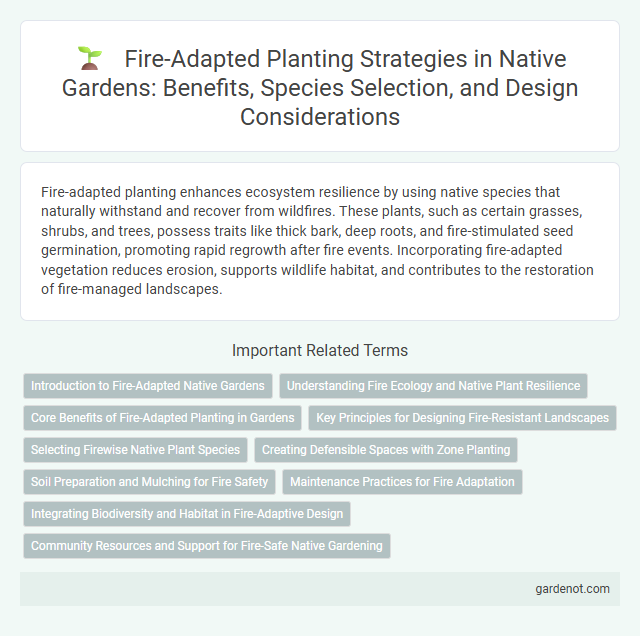Fire-adapted planting enhances ecosystem resilience by using native species that naturally withstand and recover from wildfires. These plants, such as certain grasses, shrubs, and trees, possess traits like thick bark, deep roots, and fire-stimulated seed germination, promoting rapid regrowth after fire events. Incorporating fire-adapted vegetation reduces erosion, supports wildlife habitat, and contributes to the restoration of fire-managed landscapes.
Introduction to Fire-Adapted Native Gardens
Fire-adapted native gardens incorporate plant species that naturally withstand and recover from wildfires, promoting ecosystem resilience and reducing wildfire risk. These gardens utilize fire-resistant native plants such as manzanita, chamise, and ceanothus, which have evolved traits like thick bark and deep root systems to survive fire events. Incorporating fire-adapted plants supports biodiversity, conserves water, and creates defensible space around properties in fire-prone regions.
Understanding Fire Ecology and Native Plant Resilience
Fire-adapted planting involves selecting native species that have evolved traits to survive and regenerate after wildfires, such as thick bark, deep roots, and fire-stimulated seed germination. Understanding fire ecology reveals how periodic burns maintain ecosystem health by reducing fuel loads and promoting biodiversity through natural disturbance regimes. Incorporating fire-resilient native plants enhances landscape recovery, supports wildlife habitats, and reduces wildfire risk in fire-prone regions.
Core Benefits of Fire-Adapted Planting in Gardens
Fire-adapted planting enhances garden resilience by incorporating native species that naturally survive and regenerate after wildfires, reducing the need for replanting and soil stabilization efforts. These plants improve ecosystem health by promoting biodiversity and supporting local wildlife habitats adapted to fire-prone environments. Utilizing fire-adapted vegetation diminishes fuel loads, lowering wildfire risks and protecting properties while maintaining a sustainable and low-maintenance landscape.
Key Principles for Designing Fire-Resistant Landscapes
Fire-resistant landscapes prioritize selecting native plants with high moisture content and low resin levels to reduce flammability. Proper spacing between vegetation minimizes fuel continuity and helps slow fire spread, while incorporating hardscape elements like gravel or stone pathways creates effective firebreaks. Strategic layering of plants, combining low-growing groundcovers with widely spaced shrubs and trees, enhances the landscape's ability to withstand and recover from wildfire exposure.
Selecting Firewise Native Plant Species
Selecting firewise native plant species involves choosing vegetation with high moisture content, low resin levels, and minimal dead material to reduce flammability. Fire-adapted plants such as manzanita, ceanothus, and lemonade berry have evolved traits like thick bark and resprouting ability that enhance landscape resilience. Incorporating these species strategically supports efficient fire management and promotes ecological health in fire-prone areas.
Creating Defensible Spaces with Zone Planting
Fire-adapted planting involves creating defensible spaces by using zone planting to reduce wildfire risk. Zone planting strategically arranges native vegetation into zones based on proximity to structures, with low-flammability plants placed closest to buildings and higher-flammability species farther away. This method enhances fire resistance, improves safety, and supports ecological balance in fire-prone landscapes.
Soil Preparation and Mulching for Fire Safety
Soil preparation for fire-adapted planting involves removing flammable materials and incorporating fire-resistant organic matter to enhance moisture retention and nutrient availability. Mulching with inorganic or fire-resistant organic mulch reduces surface ignition risk by creating a protective barrier, minimizing soil exposure and preventing weed growth. Proper soil preparation combined with strategic mulching significantly improves plant resilience and overall fire safety in native landscaping.
Maintenance Practices for Fire Adaptation
Fire-adapted planting requires regular maintenance practices such as pruning dead branches, removing highly flammable debris, and managing plant density to reduce fuel loads. Selecting fire-resistant native species with high moisture content helps minimize fire risk while supporting local ecosystems. Consistent monitoring and proper irrigation during dry seasons are essential for maintaining plant health and enhancing fire resilience.
Integrating Biodiversity and Habitat in Fire-Adaptive Design
Fire-adapted planting leverages native species that thrive under periodic fire regimes, promoting ecosystem resilience and biodiversity. Integrating fire-resilient plants such as manzanita, ceanothus, and chaparral scrub enhances habitat complexity for wildlife while reducing fuel loads. Strategic placement of these species supports natural fire cycles, safeguards soil health, and sustains diverse habitats critical for pollinators and bird populations.
Community Resources and Support for Fire-Safe Native Gardening
Community resources for fire-adapted planting offer valuable support through workshops, local native plant nurseries, and fire-safe landscaping guides designed specifically for fire-prone areas. Collaboration with fire departments and conservation groups provides homeowners with tailored advice on selecting fire-resistant native species such as manzanita, California lilac, and ceanothus. Access to grants and educational programs further empowers communities to implement sustainable, fire-safe native gardening practices that enhance ecosystem resilience and reduce wildfire risk.
Fire-adapted planting Infographic

 gardenot.com
gardenot.com